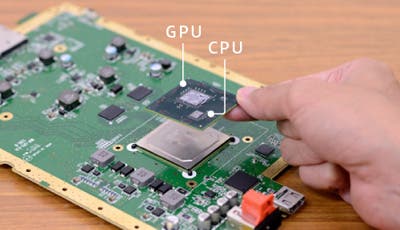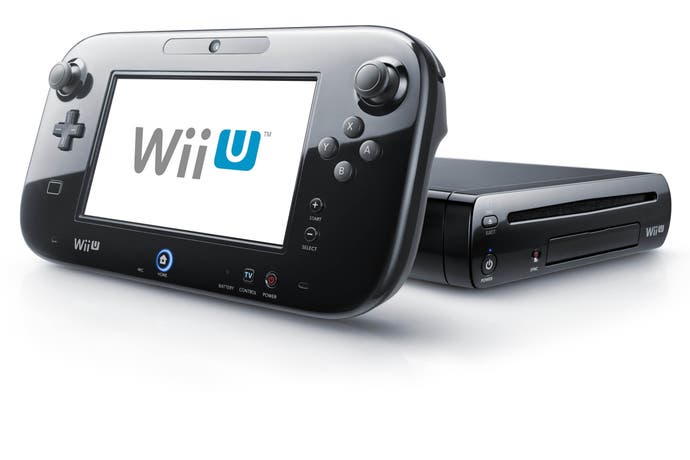Wii U has 1.24GHz CPU, 550MHz graphics core - report
Team Twiizers/fail0verflow member hints at Wii U hack.
Barely held back by non-disclosure agreements, game developers have expressed some disappointment with the Wii U CPU architecture but have yet to go on the record with firm information on exactly why performance is apparently so lacklustre. The closest we've got so far is Tekken Tag Tournament 2 producer Katsuhiro Harada suggesting that "creative solutions" are required as the CPU clock is "kinda low". Today, a post from Wii and PS3 hacker Marcan puts a firm figure on that, precise to six decimal places no less:
"1.243125GHz, exactly. 3 PowerPC 750 type cores (similar to Wii's Broadway, but more cache). GPU core at 549.999755MHz."
Having contributed to the discovery of exploits for the original Wii as part of Team Twiizers, as well as cooperating with other hackers as a member of fail0verflow - the team that brought down PlayStation 3 security - Marcan's figures clearly carry some weight. Asked to clarify how he acquired the information, he declined to go into specifics, but did suggest that it was the result of Wii U hacking rather than revealing leaked information. This comment alone hints that some notable progress has already been made in reverse-engineering Nintendo's new system. Hardware similarities with the older system may well have given hackers a head-start, as low-level Wii exploits have never been released and would probably remain unknown to Nintendo itself.
Marcan's comments corroborate earlier stories about the provenance of the CPU, which suggested that the cores are indeed very similar to the Broadway architecture found in the Wii, which in itself harks back to IBM's PowerPC 750 core which first debuted way back in 1997. The core was still fairly modern when it debuted in 2000's GameCube, and was up-clocked to 729MHz for the 2006 Nintendo Wii. For the transition to Wii U, clock speed has almost doubled, core count has tripled and according to Marcan, there is more on-board cache. Other sources have previously suggested further enhancements to the technology, such as out of order execution - a feature that isn't present in the Xbox 360 or PlayStation 3 CPUs.
Marcan also says that the CPU has the internal designation "Espresso" - which correlates with previous leaks - while the AMD graphics chip is code-named "Latte", information that is new to us.
The news suggests very much that Wii U is an evolution of the process that brought us the original Wii - existing architecture is sped-up and re-purposed in order to facilitate full hardware backwards compatibility with the preceding console. This is good news for those with extensive Wii libraries and peripherals, but somewhat less than welcome information for those hoping for a significant generational leap over the current-gen consoles. On clock speed alone, it's a whitewash: Xbox 360 operates at 3.2GHz with six hardware threads over three cores, equivalent to 1.6GHz per thread.
"So yes, the Wii U CPU is nothing to write home about, but don't compare it clock per clock with a 360 and claim it's much worse. It isn't."


However, Marcan reckons that the Wii U CPU shouldn't be dismissed based on clocks alone - even with the speed deficit and with only one hardware thread per core, he suggests that it's like comparing Intel's power-hungry, inefficient Pentium 4 design with the later, better-designed Core series processors.
"The Espresso is an out of order design with a much shorter pipeline. It should win big on IPC on most code, but it has weak SIMD", he reckons.
Asked whether his clock speed metrics may apply to the CPU running in an idling state, Marcan ruled out the idea, suggesting that "1.24G is exactly in line with what we expected for a 750-based design".
"So yes, the Wii U CPU is nothing to write home about, but don't compare it clock per clock with a 360 and claim it's much worse. It isn't," he concludes.
However, clearly there are issues, as our recent Face-Offs have demonstrated. Moore's Law uses the amount of transistors packed onto a piece of silicon as a rough indication of 'power'. With a die-size measured at 33mm2, the Wii U CPU is far, far smaller than the processors in the Xbox 360 and PlayStation 3. With the Xenon processor in the Xbox 360's combined CPU/GPU chip clocking in at around 70mm2, the entire Wii U CPU uses around the same amount of silicon as one 360 core plus the L2 cache. Both console processors are believed to be produced with a 45nm fabrication process, so the transistor densities involved are roughly comparable. With a deficit like that, even with a generational boost in efficiency, it'll be hard for the Wii U CPU to make up the difference, perhaps explaining why developers are finding Espresso challenging to work with.
We are currently reaching out to development sources in an effort to corroborate Marcan's findings.








